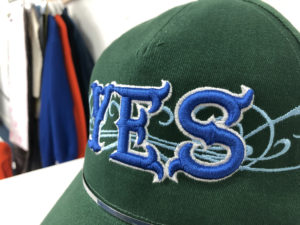
In an industry that is constantly expanding and pushing the possibilities of current technologies, it’s important to experiment with different techniques in order to create new, unique and eye-catching designs.
This is where 3D embroidery can take centre stage. John-Paul Burton, sales director at Your Embroidery Services Ltd, elaborates.
While it’s not a new technique, 3D embroidery, also known as 3D puff, has become a popular creative choice among embroiderers.
It’s a great technique to use if you want to give your designs something extra to help them to stand out amongst the crowd. It can also open up further opportunities to expand the creative qualities of your designs.
What is 3D embroidery?
3D embroidery is the technique of using a foam topping to raise the surface of your design and give it a three-dimensional feel. You can completely transform your products into something more unique and creative by mixing 3D embroidered elements into your standard flat embroidery design.
This embroidery technique can be applied to a range of heavyweight apparel that doesn’t require much washing, such as jackets and other outerwear. However, the most common use is seen on caps in order to emphasise brands or logos.
It’s important to remember that 3D embroidery is different from standard flat embroidery. This means that there are a few things that need to kept in mind when making the choice to attempt this technique.
How should your digitising differ from flat embroidery?
It’s always important to understand the end goal of your embroidery because this will affect the way that you digitise your design. Different fabrics require a design to be digitised differently, and creating a design for 3D embroidery is no exception.
The first thing that needs to be taken into account when digitising the design is that the edges will need to be capped. The effect won’t be obvious when you look at the finished design but it’s incredibly important. Forgetting to include this stage will result in you being unable to tear away the excess foam from the shapes in the design, ruining the finished product.
The stitch density will also need to be increased when digitising the design. You might want to increase the density by up to three times the amount that you would usually use for flat embroidery. When working with 3D embroidery, this will give the design much better coverage and prevent any foam from sticking out between the stitches. It also has an added benefit of giving you a more effective cut action to make tearing away the excess foam neater and easier.
The final thing that needs to be considered when it comes to digitising is the stitch length. Foam will greatly increase the thickness of the material that you’re embroidering onto, so you should allow your stitches to be a little bit longer in order to take this depth into account.
How should your actual embroidery technique differ?
Not only does your digitising need to differ to better suit 3D embroidery, your embroidery machine should be adapted too.
When setting up your embroidery machine, the tension won’t need to be as high as it would be for flat embroidery. If the tension is too high then the stitches may pull too tight on the edges where the foam thins, giving the design a curved look rather than the optimal raised effect.
Finally, the type of needles used in the embroidery machine will need to be decided to give the best results. A ball point needle isn’t suitable for this type of embroidery. Instead we recommend using a regular point needle because it gives you the required sharpness to tear through the foam effectively.
Using foam for 3D embroidery will give your design a great finish, however it can be difficult to master at first. If you’re new to the technique, we recommend starting with a thinner foam before working your way up in thickness. Although the 3D effect won’t be as profound, a thinner foam is much easier to work with until you get your footing.
It’s great to try new techniques and step out of your comfort zone, we’re fortunate to be a part of an incredibly talented and creative industry. Just remember to take the time to practice and perfect your technique.
 Printwear & Promotion The Total Promotional Package
Printwear & Promotion The Total Promotional Package




